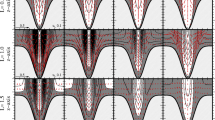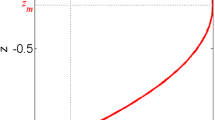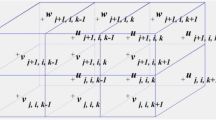Abstract
In a weakly nonlinear tidal system, the depth-averaged equations for the first-order Lagrangian residual velocity (LRV) are deduced systematically. For the case of a narrow bay, the equations are solved analytically and the results for a specific bottom profile are discussed in detail. According to the pattern of the first-order LRV, the bay can be divided into three parts, namely an inner part, a transitional zone, and an outer part. For the given depth profile, the streamline of the first-order LRV for a shorter bay is a part of that for a longer bay. The first-order LRV depends on a nondimensional parameter that combines the influences of the bottom friction coefficient, the tidal period and the averaged water depth. The form of the bottom friction also has a significant influence on the first-order LRV. The second-order LRV, i.e., the Lagrangian drift, is analytically solved and shows dependence on the initial tidal phase. The LRV differs from the Eulerian residual transport velocity both quantitatively and qualitatively. It is demonstrated that the residual currents obtained according to other definitions may cause misunderstanding of the mass transport in water exchange applications.














Similar content being viewed by others
References
Abbott MR (1960) Boundary layer effects in estuaries. J Mar Res 18:83–100
Cerco CF, Cole T (1993) Three-dimensional eutrophication model of Chesapeake Bay. J Environ Eng 119:1106–1125
Cheng RT (1983) Euler-Lagrangian computations in estuarine hydrodynamics. In: Taylor J, Johnson A, Smith R (eds) Proceedings of third international conference on numerical methods in laminar and turbulent flow. Pineridge, Swansea. pp 341–352
Cheng RT, Casulli V (1982) On Lagrangian residual currents with applications in South San Francisco Bay, California. Water Resour Res 18:1652–1662
Delhez EJM (1996) On the residual advection of passive constituents. J Mar Syst 8:147–169
Dortch MS, Chapman RS, Abt SR (1992) Application of three-dimensional Lagrangian residual transport. J Hydraul Eng 118:831–848
Dyke PPG (1980) On the Stokes’ drift induced by tidal motions in a wide estuary. Estuarine Coastal Mar Sci 11:17–25
Feng S (1987) A three-dimensional weakly nonlinear model of tide-induced Lagrangian residual current and mass-transport, with an application to the Bohai Sea. In: Nihoul JCJ, Jamart BM (eds) Three-dimensional models of marine and estuarine dynamics, Elsevier Oceanography Series, 45. Elsevier, Amsterdam. pp 471–488
Feng S (1990) On the Lagrangian residual velocity and the mass-transport in a multi-frequency oscillatory system. In: Cheng RT (ed) Residual currents and long-term transport, Coastal and Estuarine Studies 38. Springer, Berlin, pp 34–48
Feng S (1998) On circulation in Bohai Sea Yellow Sea and East China Sea. In: Hong GH, Zhang J, Park BK (eds) Health of the Yellow Sea. The Earth Love Publication Association, Seoul, pp 43–77
Feng S, Wu D (1995) An inter-tidal transport equation coupled with turbulent K-ϵ model in a tidal and quasi-steady current system. Chin Sci Bull 40:136–139
Feng S, Xi P, Zhang S (1984) The baroclinic residual circulation in shallow seas. Chin J Oceanol Limnol 2:49–60
Feng S, Cheng RT, Xi P (1986a) On tide-induced Lagrangian residual current and residual transport, 1. Lagrangian residual current. Water Resour Res 22:1623–1634
Feng S, Cheng RT, Xi P (1986b) On tide-induced Lagrangian residual current and residual transport, 2. residual transport with application in South San Francisco Bay. Water Resour Res 22:1635–1646
Feng SZ, Ju L, Jiang WS (2008) A Lagrangian mean theory on coastal sea circulation with inter-tidal transports, I. fundamentals. Acta Oceanol Sin 27:1–16
Fischer HB, List EJ, Koh R, Imberger J, Brooks NH (1979) Mixing in inland and coastal waters. Academic, New York
Foreman MGG, Baptista AM, Walters RA (1992) Tidal model studies of particle trajectories around a shallow coastal bank. Atmos Ocean 30:43–69
Hainbucher D, Wei H, Pohlmann T, Sündermann J, Feng S (2004) Variability of the Bohai Sea circulation based on model calculations. J Mar Syst 44:153–174
Hunt JN (1961) Oscillations in a viscous liquid with an application to tidal motion. Tellus 13:79–84
Ianniello JP (1977) Tidally induced residual currents in estuaries of constant breadth and depth. J Mar Res 35:755–786
Jay DA (1991) Estuarine salt conservation: a Lagrangian approach. Estuarine, Coastal Shelf Sci 32:547–565
Li C, O’Donnell J (2005) The effect of channel length on the residual circulation in tidally dominated channels. J Phys Oceanogr 35:1826–1840
Li C, Valle-Levinson A (1999) A two-dimensional analytic tidal model for a narrow estuary of arbitrary lateral depth variation: the intratidal motion. J Geophys Res 104:23,525–23,543
Li C, Chen C, Guadagnoli D, Georgiou IY (2008) Geometry-induced residual eddies in estuaries with curved channels: observations and modeling studies. J Geophys Res 113:C01,005. doi:10.1029/2006JC004031
Loder JW (1980) Topographic rectification of tidal currents on the sides of Georges Bank. J Phys Oceanogr 10:1399–1416
Longuet-Higgins MS (1969) On the transport of mass by time-varying ocean currents. Deep-Sea Res 16:431–447
Maxima.sourceforge.net (2009) Maxima, a computer algebra system version 5.18.1. Available at: http://maxima.sourceforge.net. Accessed 14 July 2010
Muller H, Blanke B, Dumas F, Lekien F, Mariette V (2009) Estimating the Lagrangian residual circulation in the Iroise sea. J Mar Syst 78:S17–S36. doi:10.1016/j.jmarsys.2009.01.008
Nihoul ICJ, Ronday FC (1975) The influence of the tidal stress on the residual circulation. Tellus A 27:484–489
Piessens R, de Doncker-Kapenga E, Überhuber C, Kahaner D (1983) Quadpack: a subroutine package for automatic integration, springer series in computational mathematics, vol 1. Springer, Berlin
Proudman J (1953) Dynamical oceanography. Methuen, London
Ridderinkhof H, Loder JW (1994) Lagrangian characterization of circulation over submarine banks with application to the outer Gulf of Maine. J Phys Oceanogr 24:1184–1200
Robinson IS (1983) Tidally induced residual flows. In: Johns B (ed) Physical oceanography of coastal and shelf seas. Elsevier, Amsterdam, pp 321–356
Wang H, Su Z, Feng S, Sun W (1993) A three dimensional numerical calculation of the wind driven thermohaline and tide-induced Lagrangian residual current in the Bohai Sea. Acta Oceanol Sin 12:169–182
Wei H, Hainbucher D, Pohlmann T, Feng S, Sündermann J (2004) Tidal-induced Lagrangian and Eulerian mean circulation in the Bohai Sea. J Mar Syst 44:141–151
Winant CD (2007) Three-dimensional tidal flow in an elongated, rotating basin. J Phys Oceanogr 37:2345–2362
Winant CD (2008) Three-dimensional residual tidal circulation in an elongated, rotating basin. J Phys Oceanogr 38:1278–1295
Zimmerman JTF (1979) On the Euler-Lagrange transformation and the Stokes’ drift in the presence of oscillatory and residual currents. Deep-Sea Res 26A:505–520
Acknowledgements
This study was supported by project 40976003 from National Science Foundation of China and National Basic Research Program of China (2010CB428904). We thank the two anonymous reviewers for constructive comments on the original manuscript.
Author information
Authors and Affiliations
Corresponding author
Additional information
Responsible Editor: Richard John Greatbatch
Appendix: The derivation of equations for uL
Appendix: The derivation of equations for uL
By applying the operator (Eq. 26) to Eq. 18 and making use of the definition of u E in Eq. 3, one gets
The substitution of Eqs. 23–25 into Eq. 4 gives
By performing \( \partial / \partial x\) (Eq. 53) + \( \partial / \partial y\) (Eq. 54) and taking into consideration of Eq. 52, the continuity equation of u L , Eq. 27, can be obtained.
The momentum equations of the LRV are derived as follows. By applying Eq. 26 to Eq. 19 and making use of Eq. 2, one gets
By applying the operator \((\xi_0 \partial/\partial x+\eta_0 \partial/\partial y)\) to Eq. 14 and making use of Eq. 15, followed by applying Eq. 26, one yields
The left side of Eq. 56 is rearranged with integration by parts. Furthermore, by making use of Eq. 6 and the periodicity of the variables, one gets
Then by changing Eq. 56 to the following form
and by adding Eq. 55 to the above equation, one gets
By applying \( \xi_0\partial/\partial x\) to Eq. 14, one obtains
and then \( \partial/\partial x \) [ξ 0 · (Eq. 14)] leads to
Then, Eq. 59 is multiplied with 2 and subtracted with Eq. 60; and the resulting equation is averaged over one tidal period. By making use of Eq. 6 and the periodicity of the zeroth-order solution, one obtains
Substituting Eq. 61 into Eq. 58 leads to
For the case of single tidal frequency \(\langle \xi_0 u_0 \rangle =\langle \eta_0 \upsilon_0 \rangle=0\), thus
By applying the above results to Eq. 62, Eq. 28 can be obtained. It is trivial to obtain the momentum equation in the y direction.
Rights and permissions
About this article
Cite this article
Jiang, W., Feng, S. Analytical solution for the tidally induced Lagrangian residual current in a narrow bay. Ocean Dynamics 61, 543–558 (2011). https://doi.org/10.1007/s10236-011-0381-z
Received:
Accepted:
Published:
Issue Date:
DOI: https://doi.org/10.1007/s10236-011-0381-z




